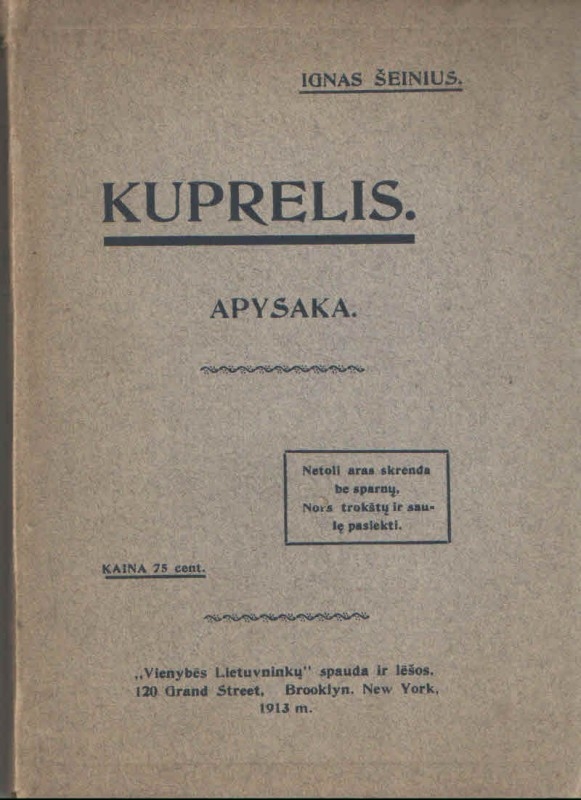
- Kuprelis
- Published by: Various
- Level: Intermediate
- First Published in: 1913
Having fallen from a high place during childhood, Olesius has to endure a physical deformity for the rest of his life. Nicknamed Kuprelis by his neighboring villagers - which means "little hunchback" in Lithuanian - he tries and fails at love, all the while cultivating a passion for art and philosophy.
Consciously intending to modernize Lithuanian prose, Ignas Šeinius moved away from the social realities of his time and instead emphasized the inner worlds of his characters. In his writings, Šeinius subtly and beautifully tells romantic and oftentimes tragic stories. Emotions that other authors only briefly identify are expanded into paragraphs by Šeinius. Kuprelis, one of his most prominent pieces, serves as a perfect example of his poetic style.
"Ignas Šeinius moved away from the social realities of his time and instead emphasized the inner worlds of his characters."
The novel is about personal tragedy. The protagonist is named Olesius, but he is called Kuprelis by the villagers, which literally means “little hunchback,” since the suffix “-el-“ is a diminutive in Lithuanian. He retrospectively tells his story to a young student. As a child, he fell from a high place, so Kuprelis has two hunches, one on his back and another on his chest. He remembers how he moved away from home to learn how to play the organ, and how, later, he worked as an organist at a church. At that time, he met a young a girl, named Gundė, and they both fell in love. But Kuprelis’s looks were not good enough for Gundė’s parents, and in the end, instead of disobeying, she ran away with another boy and abandoned Kuprelis. Devastated, he went to work in a mill, where he continued to write and enlighten himself in philosophy, art, and other subjects, only deepening his sensitive personality.

As is often found in Šeinius’s work, it is the inner action and not the narrative itself that drives the novel. In addition to love-induced suffering, the main themes are music, religion, and closeness to nature. The way Kuprelis talks about nature reveals his empathetic character: “Visas vakaras, visa gamta svajingai supasi, linguoja“ (The whole evening, all nature, is romantically swinging, rocking). “Supasi” and “linguoja,” interestingly, are words more often used to describe people. “Linguoja” could be translated as “rocking” or “swaying,” and could in fact refer to the movements of trees. Kuprelis identifies with nature and sees himself as one with it. “Svajingai” also means “in a dreamy way,” and thus, when combined, the words “svajingai supasi, linguoja” anthropomorphize the natural environment.
"A personal tragedy and its poetic account: Ignas Šeinius at his best."
Lastly, Šeinius’s choice of name for Kuprelis’s beloved girl deserves a brief analysis. The name “Gundė” in Lithuanian derives either from the word for “seduction” or “temptation” (gundymas) or the verb “to seduce” (gundyti). Therefore, despite the fact that her behavior could not be considered openly inviting (she asks Kuprelis if he could walk her home, but that is where her potential seduction ends), the name itself juxtaposes Kuprelis’s church work. Her name, in a way, is the opposite of what Kuprelis’s life has been about: reading, writing, and being entirely by himself. “I have been tempted by science for a long time,” says Kuprelis, making it his new passion after his human flame has been lost.
Kuprelis is a story about a dreamer, a highly empathetic artist with a feeling for nature and music, whose rejection by his beloved pushes him into the delicate company of solitude. A personal tragedy and its poetic account: Ignas Šeinius at his best.

